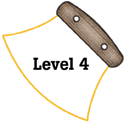
Alaska Science
Key Element A8c
 |
Alaska Science |
|
Performance Standard Level 4, Ages 15–18
|
|
|
|
Sample Assessment Ideas
|
|
|
Expanded Sample Assessment Idea
|
|
Procedure Students will:
Reflection and Revision
|
Levels of Performance |
||
|
Stage 4 |
Student work is complete, and shows clear understanding of kinetic and positional energy (entropy) and how these relate to processes and change. Measurements, data, observations, and inferences are detailed and accurate. An accurate model and poster are created, and used to effectively explain energy and entropy interactions. | ||
|
Stage 3
|
Student work is mostly complete, and shows understanding of kinetic and positional energy (entropy) and how these relate to processes and change. Measurements, data, observations, and inferences are appropriate, although they may contain minor errors or omissions. A reasonable model and poster are created, and used to describe energy and entropy interactions. | ||
|
Stage 2
|
Student work may be incomplete, and shows limited understanding of kinetic or positional energy (entropy) or how they relate to processes and change. Measurements, data, observations, and inferences are incomplete, incorrect or lack detail and logical reasoning. Model and poster may show evidence of skilled craftsmanship but cannot be used to describe energy interactions. | ||
|
Stage 1
|
Student work is mostly incomplete, and shows little or no understanding of energy or entropy. Data and observations are incomplete or incorrectly recorded. Model and poster may show evidence of skilled craftsmanship but are inaccurate and do not support explanations. | ||
Standards Cross-References
|
||
|
National Science Education Standards Heat consists of random motion and the vibrations of atoms, molecules, and ions. The higher the temperature, the greater the atomic or molecular motion. (Page 180) The total energy of the Universe is constant. Energy can be transferred by collisions in chemical and nuclear reactions, by light waves and other radiations, and in many other ways. However, it can never be destroyed. As these transfers occur, the matter involved becomes steadily less ordered. (Page 180) Everything tends to become less organized and less orderly over time. Thus, in all energy transfers, the overall effect is that the energy is spread out uniformly. Examples are the transfer of energy from hotter to cooler objects by conduction, radiation, or convection and the warming of our surroundings when we burn fuels. (Page 180) |
Benchmarks Heat energy in a material consists of the disordered motions of its atoms or molecules. In any interactions of atoms or molecules, the statistical odds are that they will end up with less order than they began—that is, with the heat energy spread out more evenly. With large numbers of atoms and molecules, the greater disorder is almost certain. (Page 86) Transformations of energy usually produce some energy in the form of heat, which spreads around by radiation or conduction into cooler places. Although just as much total energy remains, its being spread out more evenly means less can be done with it. (Page 86) |
|
Table of Contents | Return to Alaska Native Knowledge Network